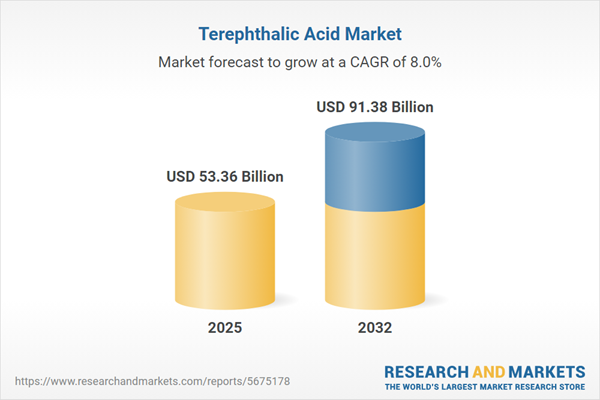Speak directly to the analyst to clarify any post sales queries you may have.
The terephthalic acid market is evolving rapidly as industry leaders address shifting supply chain models and compliance requirements. Senior executives must navigate growing complexity with agile strategies and timely insight to sustain competitive positioning in this key segment of the chemicals industry.
Market Snapshot: Terephthalic Acid Market Size and Growth Trajectory
The global terephthalic acid market is projected to expand from USD 49.44 billion in 2024 to USD 53.36 billion in 2025, with an anticipated value of USD 91.38 billion by 2032. The sector is benefitting from robust demand in chemicals, packaging, textiles, and manufacturing applications. As market expectations and innovation drivers advance, organizations are increasing their focus on compliance and supply chain optimization to support operational agility and unlock new value. Adaptable strategies remain crucial in this competitive landscape, where regulatory trends and business requirements continue to shift.
Terephthalic Acid Market Scope & Segmentation
Executive teams seeking to optimize resource allocation and manage risk benefit from a clear understanding of the category’s segmentation and drivers. This report evaluates market dynamics and operational benchmarks across key areas:
- Application: Evaluates the critical roles of terephthalic acid in coatings, industrial films, packaging films, PET bottles, and polyester fibers, which are foundational to diverse manufacturing and end-consumer products.
- Grade: Clarifies differences between coating, fiber, film, and PET grades, enabling assessment of compliance, quality, and opportunities for product specialization in target markets.
- End Use Industry: Maps the importance of this compound in the automotive, construction, food packaging, cosmetics, pharmaceuticals, electronics, and textile sectors, addressing both high-volume commodity uses and specialized niche growth.
- Process Technology: Details technologies including established cobalt-manganese methods and new no-bromide processes, supporting evaluation of regulatory compliance, environmental performance, and enhanced process efficiency amid evolving standards.
- Region: Analyzes operational, regulatory, and supply chain conditions within the Americas, Europe, Asia-Pacific, and the Middle East & Africa, guiding tailored approaches for market entry, compliance, and risk mitigation.
- Leading Companies: Highlights the influence of key industry players such as China Petroleum & Chemical Corporation, Reliance Industries, Indorama Ventures, SK Global Chemical, Toray Industries, Formosa Plastics, Qilu Petrochemical, Farabi Petrochemical, Zhejiang Petrochemical, and Mitsui Chemicals, presenting strategic direction and innovation pathways.
Key Takeaways: Strategic Insights for Senior Terephthalic Acid Market Leaders
- Sustainability strategies increasingly emphasize sourcing bio-based feedstocks and integrating recycling models, allowing organizations to address environmental pressures and future-proof compliance systems.
- Diversifying supplier networks and aligning procurement models with proximity reduce exposure to transport disruptions and concentration risk, reinforcing continuous operations.
- Adoption of advanced analytics and digital twin technologies supports process optimization, cost control, and actionable insights for ongoing operational enhancement.
- Refining product grades and targeted customization supports compliance with evolving sector-specific criteria, enabling businesses to address nuanced client and regulatory requirements.
- Designing regionally tailored operating strategies allows for regulatory alignment and maximizes potential in differing market environments, supporting sustained market access and agility.
Tariff Impact: Navigating Trade Shifts in the Terephthalic Acid Market
Recent US tariffs have prompted a strategic reassessment of sourcing and production approaches across the terephthalic acid segment. Organizations are diversifying procurement channels to minimize reliance on affected regions, enhancing domestic manufacturing, and developing robust contingency plans. These responses are essential for sustaining reliable supply and mitigating exposure to evolving trade and policy risks. Executives focused on chemicals supply chain management must prioritize resilient sourcing frameworks to ensure long-term stability.
Methodology & Data Sources
This analysis draws upon in-depth interviews with senior executives, comprehensive sector surveys, targeted reviews of market developments, and careful examination of financial performance. Subject-matter experts validate every key finding, offering a reliable foundation for informed strategy and risk planning.
Terephthalic Acid Market: Why This Report Matters
- Supplies actionable guidance for integrating sustainability and compliance priorities within chemicals industry operations.
- Benchmarks supply chain flexibility and technological advancement, informing effective resource and investment decisions.
- Prepares executive leadership to anticipate and address operational risks, supporting timely and agile responses to shifting market conditions.
Conclusion
Senior decision-makers can leverage these insights to guide investment, adjust resources, and support long-term growth strategies in an innovation-focused chemicals market. This report empowers executive teams to make informed choices despite increasing operational complexities.
Additional Product Information:
- Purchase of this report includes 1 year online access with quarterly updates.
- This report can be updated on request. Please contact our Customer Experience team using the Ask a Question widget on our website.
Table of Contents
3. Executive Summary
4. Market Overview
7. Cumulative Impact of Artificial Intelligence 2025
Companies Mentioned
The companies profiled in this Terephthalic Acid market report include:- China Petroleum & Chemical Corporation
- Reliance Industries Limited
- Indorama Ventures Public Company Limited
- SK Global Chemical Co., Ltd.
- Toray Industries, Inc.
- Formosa Plastics Corporation
- Qilu Petrochemical Company Limited
- Farabi Petrochemical Company
- Zhejiang Petrochemical Company Limited
- Mitsui Chemicals, Inc.
Table Information
| Report Attribute | Details |
|---|---|
| No. of Pages | 197 |
| Published | November 2025 |
| Forecast Period | 2025 - 2032 |
| Estimated Market Value ( USD | $ 53.36 Billion |
| Forecasted Market Value ( USD | $ 91.38 Billion |
| Compound Annual Growth Rate | 7.9% |
| Regions Covered | Global |
| No. of Companies Mentioned | 11 |









